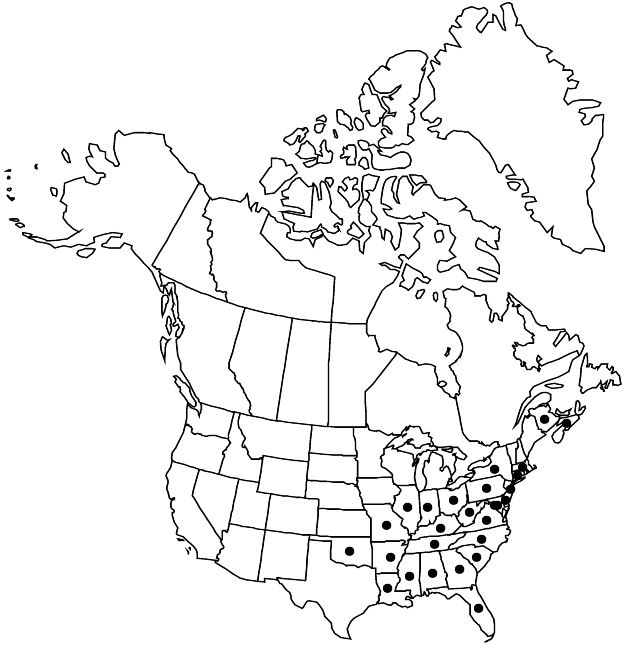Difference between revisions of "Hydrangea arborescens"
Sp. Pl. 1: 397. 1753.
FNA>Volume Importer |
imported>Volume Importer |
||
| (3 intermediate revisions by 2 users not shown) | |||
| Line 16: | Line 16: | ||
|name=Hydrangea arborescens var. oblonga | |name=Hydrangea arborescens var. oblonga | ||
|authority=Torrey & A. Gray | |authority=Torrey & A. Gray | ||
| + | |rank=variety | ||
}} | }} | ||
|hierarchy=Hydrangeaceae;Hydrangea;Hydrangea arborescens | |hierarchy=Hydrangeaceae;Hydrangea;Hydrangea arborescens | ||
| Line 32: | Line 33: | ||
|distribution=N.B.;N.S.;Ala.;Ark.;Conn.;Del.;D.C.;Fla.;Ga.;Ill.;Ind.;Ky.;La.;Md.;Mass.;Miss.;Mo.;N.J.;N.Y.;N.C.;Ohio;Okla.;Pa.;S.C.;Tenn.;Va.;W.Va. | |distribution=N.B.;N.S.;Ala.;Ark.;Conn.;Del.;D.C.;Fla.;Ga.;Ill.;Ind.;Ky.;La.;Md.;Mass.;Miss.;Mo.;N.J.;N.Y.;N.C.;Ohio;Okla.;Pa.;S.C.;Tenn.;Va.;W.Va. | ||
|discussion=<p><i>Hydrangea arborescens</i> has escaped from cultivation in Connecticut, Massachusetts, New Brunswick, and Nova Scotia; it is not native in those states or provinces.</p><!-- | |discussion=<p><i>Hydrangea arborescens</i> has escaped from cultivation in Connecticut, Massachusetts, New Brunswick, and Nova Scotia; it is not native in those states or provinces.</p><!-- | ||
| − | --><p>E. McClintock (1957) circumscribed <i>Hydrangea arborescens</i> as comprising three partly sympatric subspecies; subsp. arborescens, < | + | --><p>E. McClintock (1957) circumscribed <i>Hydrangea arborescens</i> as comprising three partly sympatric subspecies; subsp. arborescens, <i></i>subsp.<i> discolor</i>, and subsp. radiata. R. E. Pilatowski (1980, 1982) concluded that these were best treated as three species (<i>H. arborescens</i>, <i>H. cinerea</i>, and <i>H. radiata</i>), citing chemical, morphological, reproductive, and geographic discontinuities among the taxa. Most herbarium specimens are easily referred to one of these species; occasional specimens appear intermediate between <i>H. arborescens</i> and <i>H. cinerea</i>.</p><!-- |
--><p>The Cherokee and Delaware tribes used bark and occasionally leaves from <i>Hydrangea arborescens</i> to prepare infusions or poultices to treat various internal and external ailments. The Cherokee used peeled twigs and branches to make tea or cooked twigs and branches as a vegetable (D. E. Moerman 1998).</p> | --><p>The Cherokee and Delaware tribes used bark and occasionally leaves from <i>Hydrangea arborescens</i> to prepare infusions or poultices to treat various internal and external ailments. The Cherokee used peeled twigs and branches to make tea or cooked twigs and branches as a vegetable (D. E. Moerman 1998).</p> | ||
|tables= | |tables= | ||
| Line 42: | Line 43: | ||
-->{{#Taxon: | -->{{#Taxon: | ||
name=Hydrangea arborescens | name=Hydrangea arborescens | ||
| − | |||
|authority=Linnaeus | |authority=Linnaeus | ||
|rank=species | |rank=species | ||
| Line 57: | Line 57: | ||
|publication year=1753 | |publication year=1753 | ||
|special status=Endemic | |special status=Endemic | ||
| − | |source xml=https:// | + | |source xml=https://bitbucket.org/aafc-mbb/fna-data-curation/src/2e0870ddd59836b60bcf96646a41e87ea5a5943a/coarse_grained_fna_xml/V12/V12_244.xml |
|genus=Hydrangea | |genus=Hydrangea | ||
|species=Hydrangea arborescens | |species=Hydrangea arborescens | ||
Latest revision as of 19:14, 5 November 2020
Shrubs, 10–30 dm. Twigs strigose to hirsute, trichomes white. Leaves opposite; petiole 1.4–8.5(–11.5) cm, glabrous or glabrous abaxially and sparsely tomentose adaxially; blade ovate, elliptic-ovate, or broadly ovate, (2.7–)6–17.8 × (1.4–)2.5–12(–15.5) cm, unlobed, base cordate, truncate, or cuneate, margins dentate to serrate, apex acute to acuminate, abaxial surface green, glabrous or glabrate, or sparsely hirsute along midvein and sometimes along lateral veins, trichomes at 40× conspicuously tuberculate, 0.3–1 mm, adaxial surface green, glabrous or sparsely hirsute. Inflorescences compact, 100–500-flowered, dome-shaped to hemispheric, (3.3–)4–14 × 3.6–12 cm; peduncle 1.5–7.8 cm, sparsely tomentose. Pedicels 1–2.5 mm, glabrous or sparsely hirsute. Sterile flowers absent or present, white, greenish white, or yellowish white, tube 6–16 mm, lobes 3–4(–5), obovate to broadly ovate, round, or elliptic, 3.6–15 × 2.2–14 mm. Bisexual flowers: hypanthium adnate to ovary to near its apex, 0.7–1 × 0.8–1.2 mm, strongly 8–10(–11)-ribbed in fruit, glabrous; sepals deltate to triangular, 0.2–0.5 × 0.2–0.5 mm, margins entire, apex acute to acuminate, abaxial surface glabrous; petals caducous, white to yellowish white, elliptic to narrowly ovate, 1–1.5 × 0.6–1.1 mm; filaments 2–4.5 × 0.1–0.2 mm; anthers 0.3–0.5 mm; pistils 2(–3)-carpellate, ovary completely inferior or nearly so; styles 2(–3), distinct, 0.9–1.2 mm. Capsules hemispheric, 1.2–2.1 × 1.7–2.5 mm. Seeds 0.3–0.6(–0.8) mm. 2n = 36.
Phenology: Flowering (May–)Jun–Jul(–Aug).
Habitat: Moist to dry deciduous forests and woods, moist slopes, shaded bluffs, ledges, stream banks.
Elevation: 70–2000 m.
Distribution

N.B., N.S., Ala., Ark., Conn., Del., D.C., Fla., Ga., Ill., Ind., Ky., La., Md., Mass., Miss., Mo., N.J., N.Y., N.C., Ohio, Okla., Pa., S.C., Tenn., Va., W.Va.
Discussion
Hydrangea arborescens has escaped from cultivation in Connecticut, Massachusetts, New Brunswick, and Nova Scotia; it is not native in those states or provinces.
E. McClintock (1957) circumscribed Hydrangea arborescens as comprising three partly sympatric subspecies; subsp. arborescens, subsp. discolor, and subsp. radiata. R. E. Pilatowski (1980, 1982) concluded that these were best treated as three species (H. arborescens, H. cinerea, and H. radiata), citing chemical, morphological, reproductive, and geographic discontinuities among the taxa. Most herbarium specimens are easily referred to one of these species; occasional specimens appear intermediate between H. arborescens and H. cinerea.
The Cherokee and Delaware tribes used bark and occasionally leaves from Hydrangea arborescens to prepare infusions or poultices to treat various internal and external ailments. The Cherokee used peeled twigs and branches to make tea or cooked twigs and branches as a vegetable (D. E. Moerman 1998).
Selected References
None.